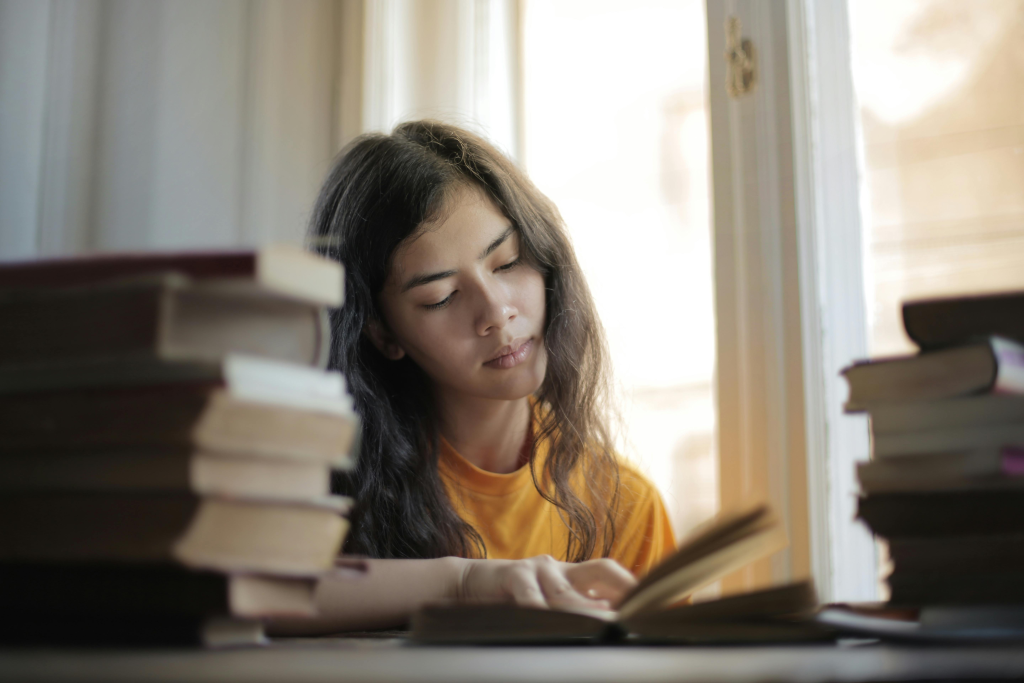Description: Psychology and English tutor, Kristina, shares her top tips for students dealing with stress or anxiety because of school.
Many people of all ages struggle with feelings of anxiety.
Anxiety might feel like butterflies in your tummy, a racing heartbeat, tight chest, or sweating.
It can make you feel worried, scared or unable to do something.
Feelings of anxiety are a normal human response to some situations, especially high-pressure or unfamiliar situations like exams, starting a new school or presenting in front of a class.
Breathe
When we feel stressed or anxious, it can feel hard to breathe and this can sometimes lead to panic.
One of the best ways of calming down our brains and bodies is through slow, regular breathing.
In the moment of anxiety, try to picture something visual to help slow down your breathing, for example smelling a beautiful flower, blowing bubbles, or blowing out the candles on a birthday cake.
Taking a big breath in through your nose and then an even longer breath out through your mouth and repeating this as many times as needed to create a steady rhythm, can really help to bring back some stability, focus and calm.
The good thing about this breathing technique is that you can do it anywhere, anytime, whether in an exam, a classroom or out in the park.
You can even choose to imagine a safe place where you feel calm and happy to help you feel settled wherever you are.
Take Time Out
One of my favourite ways to reduce anxious feelings is by spending time outdoors.
Physical movement like walking, running, yoga or cycling can help to refocus our minds, give us a healthy distraction from worry, and release endorphins (which are hormones released in our body that increase feelings of wellbeing).
Being out in nature can have a calming effect as we listen to the sounds of wildlife, look at new sights and views, and enjoy the beauty of the natural world.

It can also inspire creativity and curiosity which can help to move away from repetitive cycles of worried thoughts.
In addition, taking time out from screens can be beneficial.
There is a lot of ‘noise’ generated on social media which can sometimes increase feelings of anxiety, worry or lead us to compare ourselves to other people in an unhelpful way.
For me, having a break from my phone or laptop to take time out to think for myself, to go outside or spend some time breathing or doing something creative can really help to shift anxious feelings.
Share Your Feelings
While accepting that it is normal to feel worry or anxiety sometimes, it is still important to share these feelings with someone you trust.
There is an old saying that ‘a problem shared is a problem halved’ and I have found that, often, just saying out loud what the problem or worry is, can make it feel more manageable.

A trusted friend or adult might be able to support you in talking through the worry or help you explore ways to deal with it.
Sometimes, it might be important to speak to a professional like a doctor or counsellor, if the anxiety is significantly impacting your day-to-day wellbeing.
It can also help to share your worries by writing them down, or even drawing them.
I am a big fan of journaling and regularly write down my thoughts, feelings and musings to help me process.
I have friends who express how they feel by drawing, painting or writing music.
We can then choose to share the writing or art with someone we trust if that feels like an easier way to communicate than speaking.
The main thing is that the feelings are not trapped inside us with nowhere to go, but are released in a helpful way.
A Final Note
An important thing to remember is that you are not alone.
Anxiety is a very common feeling and it is actually your body’s way of trying to keep you safe.
When our brains detect some kind of threat, they send signals to our bodies to respond, for example giving us the quick instinct to run away, hide, freeze, avoid or fight back in the face of danger: the ‘fight, flight, freeze’ response.
Over time, we can teach our brains that certain things are not a threat.
For example, someone who had a bad experience with a dog might run away every time they see a dog in the park.
However, after meeting and petting several friendly dogs, their brain decides that not all dogs are a threat, making them less likely to instinctively run away when they see a dog in the park.
By repeating little steps like calm breathing, taking time out and sharing our feelings, we can gradually learn to manage big feelings like anxiety or stress, and cope with them in day-to-day situations.
By tutor Kristina. Contact Us




